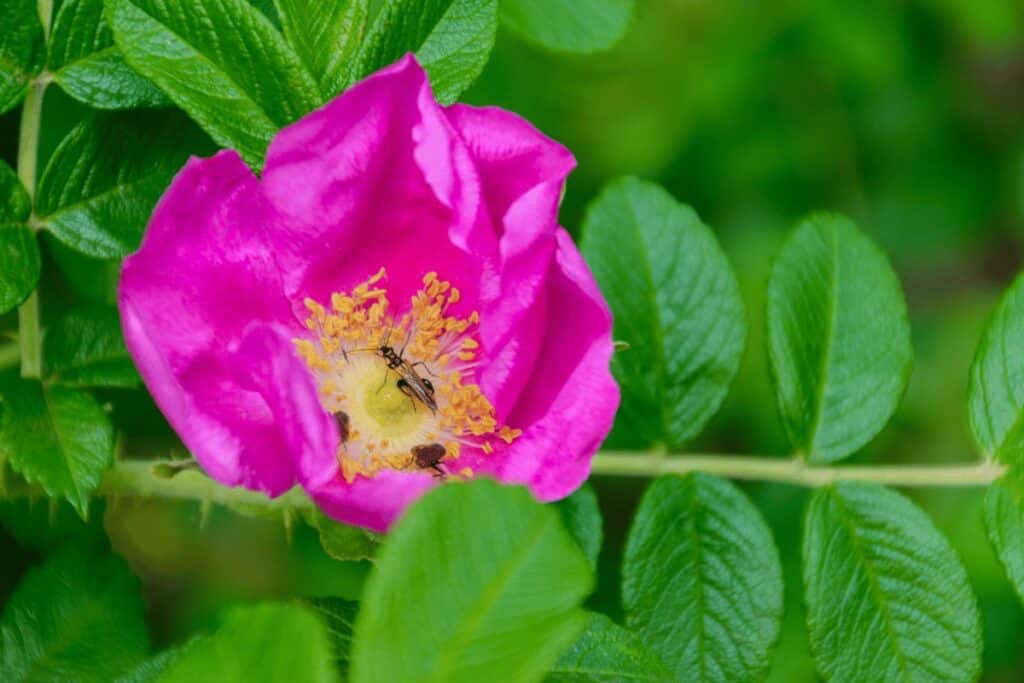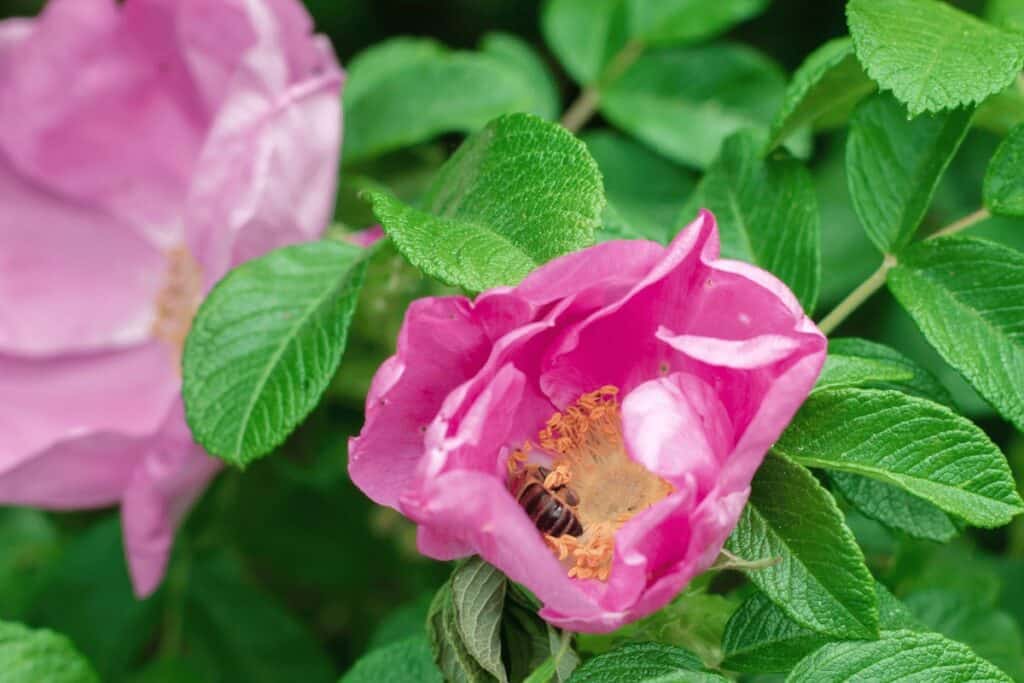Rugosa Roses, with their robust nature and captivating blooms, have become a cherished addition to gardens worldwide. These resilient plants, native to Asia, have found a special place in the hearts of gardening enthusiasts. In this article, we will explore the origins, characteristics, and myriad of reasons why Rugosa Roses are a must-have in your landscaping endeavors.
Origins and Characteristics Rugosa Roses
Native Origins
Rugosa Roses, also known as beach roses, hail from Asia, particularly in regions with coastal influences. Their ability to thrive in sandy soils and withstand harsh winds contributes to their popularity in various climates.
Distinctive Features of Rugosa Roses

One cannot overlook the unique characteristics that set Rugosa Roses apart. Their wrinkled, leathery leaves and a profusion of showy, fragrant blossoms make them stand out in any garden. The plant’s hardiness and adaptability make it a favorite among both novice and seasoned gardeners.
Popular Varieties
When delving into the world of Rugosa Roses, you’ll be delighted to discover a range of captivating varieties. From the vibrant “Hansa” to the delicate “Blanc Double de Coubert,” each type brings its own charm to the garden.
Explore Different Types and Their Unique Traits
The “Rugosa Alba” variety, with its pure white flowers, adds an elegant touch to any landscape. On the other hand, the “Roseraie de l’Hay” boasts deep crimson blooms, creating a bold visual statement.
Best Varieties for Different Climates

Whether you reside in a temperate or arid climate, there’s a Rugosa Rose variety suited for your garden. “Fru Dagmar Hastrup” thrives in cooler climates, while “Scabrosa” is a resilient choice for warmer regions.
Cultivation and Care
To ensure the success of your Rugosa Roses, it’s essential to understand their specific needs.
Soil Requirements
These roses prefer well-draining soil, but they are surprisingly adaptable. From sandy coastal soils to loamy garden beds, Rugosa Roses can flourish with minimal fuss.
Watering and Sunlight Needs
While Rugosa Roses are relatively drought-tolerant once established, consistent watering is crucial during the initial growth phase. They thrive in full sunlight but can tolerate partial shade.
Pruning Tips for Optimal Growth
Pruning plays a vital role in shaping a healthy Rugosa Rose bush. Remove dead or diseased branches and encourage airflow to prevent common issues like powdery mildew.
Benefits in Landscaping
Aesthetic Appeal
The visual allure of Rugosa Roses is undeniable. Their vibrant colors and distinctive foliage make them an eye-catching focal point in any garden.
Functionality in Hedges and Borders
Beyond their beauty, Rugosa Roses serve practical purposes in landscaping. Their thorny nature makes them excellent choices for creating natural hedges or borders, adding an extra layer of security to your outdoor space.
Disease Resistance
Natural Resilience
One of the remarkable qualities of Rugosa Roses is their inherent resistance to many common rose ailments. This natural resilience reduces the need for chemical interventions, aligning with environmentally conscious gardening practices.
Minimal Need for Pesticides
Unlike more delicate rose varieties, Rugosa Roses are less susceptible to pests. This makes them an ideal choice for those seeking a low-maintenance yet visually stunning addition to their garden.
Seasonal Blooms
Discuss the Bloom Cycle
Rugosa Roses typically bloom from late spring to early summer, gracing your garden with a burst of color and fragrance. Understanding their bloom cycle allows you to plan and enjoy a continuous display throughout the growing season.
Tips for Encouraging Continuous Flowering
To extend the bloom period, deadhead spent flowers regularly. This encourages the plant to redirect its energy into producing new blooms, ensuring a prolonged flowering season.
Rugosa Roses in History
Historical Significance
Rugosa Roses have a rich history, often associated with coastal landscapes and historical gardens. Their resilience and beauty have made them enduring symbols in various cultures.
Cultural References
From ancient Asian traditions to European gardens, Rugosa Roses have left an indelible mark. Their presence in literature and art further highlights their cultural significance.
Landscaping Ideas
Creative Ways to Incorporate Rugosa Roses
Whether you have a small balcony or a vast backyard, there are creative ways to include Rugosa Roses in your landscaping. Consider planting them in containers, creating a stunning focal point in your outdoor space.
Companion Plants for a Stunning Garden
Pairing Rugosa Roses with complementary plants enhances the overall aesthetics of your garden. Lavender, catmint, and ornamental grasses make excellent companions, creating a harmonious and visually appealing landscape.
Tips for Buying and Planting
Choosing Healthy Specimens
When selecting Rugosa Roses for your garden, choose healthy specimens with robust stems and vibrant leaves. Inspect the roots and ensure they are well-developed, indicating a strong and resilient plant.
Planting Guidelines for Success
Plant Rugosa Roses in well-prepared soil, providing adequate spacing between plants. Water thoroughly after planting, and mulch around the base to retain moisture and suppress weeds.
Rugosa Roses and the Environment
Eco-Friendly Aspects
Rugosa Roses contribute to eco-friendly gardening practices. Their resilience reduces the need for chemical inputs, promoting a more sustainable and environmentally conscious approach to landscaping.
Attracting Pollinators
The fragrant blossoms of Rugosa Roses attract pollinators, creating a vibrant ecosystem in your garden. Bees, butterflies, and other beneficial insects find refuge among the blossoms, enhancing biodiversity.
Challenges in Growing Rugosa Roses
Common Issues and Solutions
While Rugosa Roses are hardy, they are not entirely immune to challenges. Watch for common issues such as aphids or black spots, and address them promptly with organic solutions to maintain the health of your plants.
Dealing with Pests
Occasional pest issues may arise, but the thorny nature of Rugosa Roses serves as a natural deterrent. Regular inspections and natural pest control methods help keep these issues in check.
Rugosa Roses in Different Climates
Adaptability to Various Weather Conditions
One of the key attractions of Rugosa Roses is their adaptability to different climates. From the cool coastal regions to the scorching heat of inland areas, these roses can thrive with proper care.
Tips for Growing in Extreme Climates
In extreme climates, provide additional care during temperature extremes. Mulching around the base of the plants helps regulate soil temperature, protecting the roots from harsh conditions.
Fragrance and Essential Oils
Scent Profile of Rugosa Roses
The enchanting fragrance of Rugosa Roses adds another dimension to their appeal. Their sweet and spicy scent permeates the air, creating a delightful sensory experience in your garden.
Uses of Essential Oils
Harvesting Rugosa Rose petals for essential oil extraction is a rewarding endeavor. The oil finds use in perfumery, aromatherapy, and skincare products, adding a touch of luxury to your self-care routine.
Conclusion
In conclusion, Rugosa Roses bring a perfect blend of beauty, resilience, and functionality to your garden. Their rich history, diverse varieties, and ecological benefits make them a valuable addition to any landscaping project. Whether you’re a seasoned gardener or just starting, consider adding Rugosa Roses to your outdoor space for a blooming marvel that stands the test of time.
FAQs about Rugosa Roses
Are Rugosa Roses suitable for beginners?
Absolutely! Their hardiness and low-maintenance nature make them an excellent choice for novice gardeners.
How often should I water Rugosa Roses?
Water deeply once a week, adjusting based on weather conditions. These roses are drought-tolerant once established.
Can Rugosa Roses grow in containers?
Yes, Rugosa Roses can thrive in containers, making them versatile for various garden sizes.
Do Rugosa Roses attract bees and butterflies?
Yes, the fragrant blooms attract pollinators, contributing to a vibrant garden ecosystem.
What is the best time to prune Rugosa Roses?
Prune in late winter or early spring before new growth begins for optimal results.
Additional Information
https://www.gardenia.net/plant/rosa-rugosa-rugosa-rose
https://www.hardyfruittrees.ca/produit/all-trees/rugosa-rose/
https://en.wikipedia.org/wiki/Rosa_rugosa
Latest Posts
- What Types of Lettuces Can You Grow?

- How to Plant Onion Seeds for Maximum Germination

- How to Plant Parsnip Seeds for Maximum Germination

- How to Plant Mushroom Seeds for Maximum Germination

- How to Plant Lettuce Seeds for Maximum Germination

- How to Plant Kale Seeds: A Step-by-Step Guide to Maximum Germination Success!






2 responses to “Rugosa Roses: A Blooming Marvel in Your Garden”
I really like reading through a post that can make men and women think. Also, thank you for allowing me to comment!
Thank you